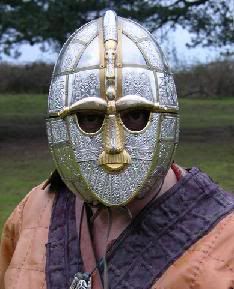Huge Anglo-Saxon treasure trove found
Posted: 2009-09-24 12:09pm
Beeb
This country never ceases to me amaze me
Quite an interesting find - There has also been jewels found in it that could potentially be from Sri Lanka, which I suppose could have been a hand-me-down from the Byzatine trading.Huge Anglo-Saxon gold hoard found
The UK's largest haul of Anglo-Saxon treasure has been discovered buried beneath a field in Staffordshire.
Experts say the collection of 1,500 gold and silver pieces, which may date to the 7th Century, is unparalleled in size and worth "a seven figure sum".
It has been declared treasure by South Staffordshire coroner Andrew Haigh, meaning it belongs to the Crown.
Terry Herbert, who found it on farmland using a metal detector, said it "was what metal detectorists dream of".
It may take more than a year for it to be valued.
The Staffordshire Hoard contains about 5kg of gold and 2.5kg of silver, making it far bigger than the Sutton Hoo discovery in 1939 when 1.5kg of Anglo-Saxon gold was found near Woodbridge in Suffolk.
Leslie Webster, former keeper at the British Museum's Department of Prehistory and Europe, said: "This is going to alter our perceptions of Anglo-Saxon England as radically, if not more so, as the Sutton Hoo discoveries.
"(It is) absolutely the equivalent of finding a new Lindisfarne Gospels or Book of Kells."
The Book of Kells and Lindisfarne Gospels are intricately illuminated manuscripts of the four New Testament Gospels dating from the 9th and 8th Centuries.
'Just unbelievable'
Mr Herbert, 55, of Burntwood in Staffordshire, who has been metal detecting for 18 years, came across the hoard as he searched land belonging to a farmer friend over five days in July. The exact location has not been disclosed.
"I have this phrase that I say sometimes; 'spirits of yesteryear take me where the coins appear', but on that day I changed coins to gold," he said.
"I don't know why I said it that day but I think somebody was listening and directed me to it.
"This is what metal detectorists dream of, finding stuff like this. But the vast amount there is is just unbelievable."
BBC correspondent Nick Higham said the hoard would be valued by the British Museum and the money passed on to Mr Herbert and the landowner.
A total of 1,345 items had been examined by experts, although the list included 56 clods of earth which had been X-rayed were are known to contain further metal artefacts.
This has meant the total number of items was likely to rise to about 1,500.
Experts have so far established that there were at least 650 items of gold in the haul, weighing more than 5kgs (11lb), and 530 silver objects totalling more than 1kg (2.2lb) in weight.
Copper alloy, garnets and glass objects were also discovered at the undisclosed site.
Duncan Slarke, finds liaison officer for Staffordshire, was the first professional to see the hoard which contains warfare paraphernalia, including sword pommel caps and hilt plates inlaid with precious stones.
He said he was "virtually speechless" when he saw the items.
"I saw boxes full of gold, items exhibiting the very finest Anglo-Saxon workmanship," he added.
Roger Bland, head of portable antiquities and treasure at the British Museum, said: "The most we can say is, I think we're fairly confident it is likely to be a seven-figure sum."
'Truly remarkable'
The collection is currently being kept in secure storage at Birmingham Museum and Art Gallery but a selection of the items are to be displayed at the museum from Friday until 13 October.
Dr Kevin Leahy, who has been cataloguing the find for the Portable Antiquities Scheme, said it was "a truly remarkable collection".
He said it had been found in the heartland of the Anglo-Saxon kingdom of Mercia.
"All the archaeologists who've worked with it have been awestruck," he added.
"It's been actually quite scary working on this material to be in the presence of greatness."
He said the most striking feature of the find was that it was almost totally weapon fittings with no feminine objects such as dress fittings, brooches or pendants.
"Swords and sword fittings were very important in the Anglo-Saxon period," Dr Leahy added.
"The Anglo-Saxon poem Beowulf describes after a battle a sword being stripped of its hilt fittings.
"It looks like a collection of trophies, but it is impossible to say if the hoard was the spoils from a single battle or a long and highly successful military career.
"We also cannot say who the original, or the final, owners were, who took it from them, why they buried it or when.
"It will be debated for decades."
This country never ceases to me amaze me
